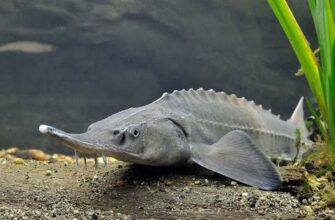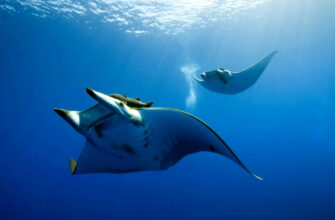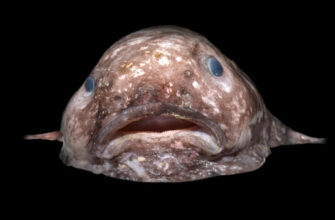Today it is difficult to meet a person who has never heard of such an animal as the great white shark. This ancient and unique animal is shrouded in a trail of danger and mystery, in which modern cinema and the media have played a significant role.
Is it really a cruel and merciless killer hunting people? Why does the great white shark take pride of place among the most dangerous creatures on the planet? Interest in this mysterious person does not subside to this day. There is another interesting underwater predator — whale shark. Read it, you’ll love it.
Species origin and description
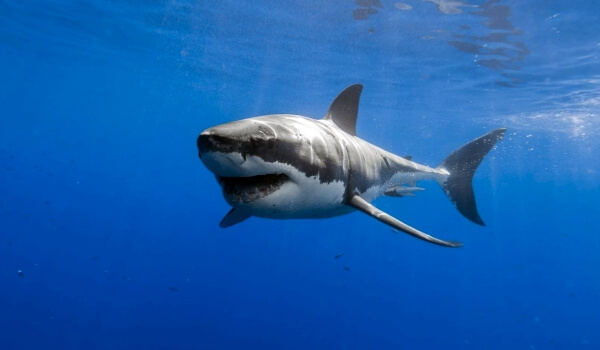
Photo: White shark
The modern scientific world cannot come to a consensus on the question: where did great white sharks come from on Earth? Supporters of one of the theories believe that this is a direct descendant of the oldest giant fish — megaladon, extinct about 3 million years ago. The alleged ancestor had incredible dimensions, which are difficult to even imagine today – 30 m in length and weighing more than 50 tons.
Representatives of the opposite theory of the origin of white sharks are sure that this unique animal has survived to this day thanks to the evolution of one of the extinct subspecies of sharks – mako. Both predators belong to the herring shark family and have a similar tooth structure. The white shark, or as it is also commonly called, the carcharodon, is a cartilaginous fish, the skeleton of which does not have hard bones, but consists entirely of soft and elastic cartilage. Due to its streamlined body, reminiscent of a combat torpedo, this shark belongs to the lamniform order.
Despite numerous disputes related to the origin of the great white shark, the world scientific community unanimously agrees on one thing – it is an ancient, dangerous, aggressive and extremely intelligent predator, the study of which has not stopped until now. And the more dangerous the object of research, the more interesting it is to observe it.
Appearance and features
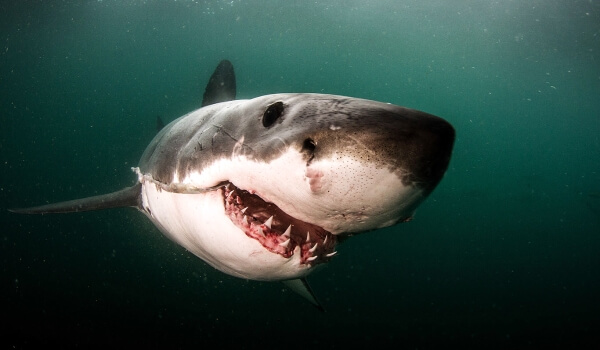
Photo: White Shark Teeth
The great white shark has a powerful, agile, torpedo-shaped, streamlined body that allows it to move at incredible speeds. Massive cone-shaped head, bordered by small, far-set eyes and a pair of nostrils. Two small olfactory furrows lead to the nose of the predator, which allows her to smell the slightest fluctuations in the water and the smell of prey at a distance of several kilometers.
The dorsal and caudal fins of the white shark are of outstanding size and often become visible on the surface of the water. The lateral, anal and ventral fins are visually less pronounced, as in all representatives of this genus of fish. Five deep gill slits are located directly behind the head on both sides and provide the breathing process.
The color of the great white shark does not quite justify its name. The dorsal and lateral parts of the animal are most often dark gray, brown, blue or even green. This allows the shark to become as invisible as possible in the water column. But the belly of a sea predator is almost always white or milky.
Among the outstanding features that put the white shark on a par with other dangerous predators of the planet are the following:
- huge size;
- an adult white shark at its peak reaches 4 to 5 meters in length;
- females are usually much larger than males;
- the average body weight of a predator ranges from 700 to 1000 kg. However, history knows cases of meeting with sharks 7, 10 and even 11 meters long. There are legends about the incredible size of this thunderstorm of the seas. To date, the largest white shark caught is officially considered to be a specimen caught in a herring net off the coast of Canada in 1930. The length of this individual was 11 meters 30 centimeters;
- wide mouth, armed with razor-sharp teeth. The great white shark has about 300 teeth in total. They have notches on the sides, allowing their mistress to butcher prey quickly and deftly, as if with a saw or an ax. The teeth are arranged in several rows – most often there are five of them. Over the entire lifespan of a shark, its teeth are completely renewed several times;
- the absence of a swim bladder. This feature forces the white shark to constantly move without sleep and rest in order not to drown.
Where does the great white shark live?
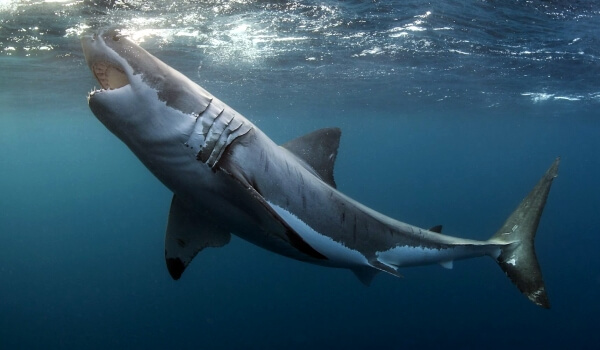
Photo: White Shark Mouth
Great White Shark lives in almost all oceans of our planet, with the exception of the Arctic.
Most often this dangerous predator can be found in the following locations:
- South coast of California;
- South African coast;
- Mexico;
- Australia;
- New Zealand.
Most white sharks prefer to stay on the surface of the water warmed by the warm rays of the sun up to 15-25C. The most shocking attacks of these sea hunters were recorded in shallow water. They rarely go deep or into the cold waters of the open ocean, but this does not mean that they cannot be found there.
One of the characteristics inherent in the great white shark is its ability or even passion for long migrations. Scientists have recorded cases when some individuals traveled incredibly long distances from one continent to another and back. The true reason for such movements is still unknown. It can be both a craving for procreation, and the search for richer food shores.
In general, the white shark is quite unassuming in terms of habitat and breeding. Few other marine creatures can compete with it in terms of hunting, so it can feel like the mistress of the situation in any waters of the world’s oceans.
What does the great white shark eat?
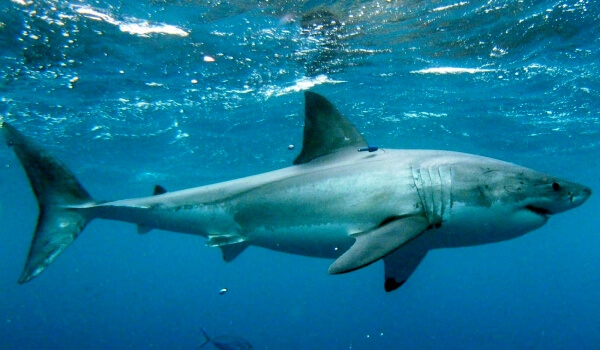
Photo: Great White Shark Dimensions
There is an opinion that the shark is able to eat anything, regardless of taste and size. This is partly true, there have been cases when the most unexpected items were found in the stomachs of great white sharks – from glass bottles to underwater bombs. However, if we talk about the animal diet of these fearless predators, then fish and shellfish of various breeds and sizes come to the fore, first of all. Juveniles eat a large amount of small-sized, but, nevertheless, fatty and nutritious herring, sardine and tuna. As the white shark matures, small whales, the bottlenose dolphin, fur seals and sea lions, as well as other sharks, become too tough for her.
Surprising is the fact that such a skilled hunter will never refuse carrion, and the shark will smell its indescribable aroma for several tens of kilometers. One large decomposing carcass of a dead whale can feed a white shark for about a month. Of particular interest is the hunting skill of the great white shark. Lying in wait for a fur seal, the predator can swim in the water column for a long time, as if not noticing the victim, and then abruptly jump to the surface, grabbing the prey with a death grip of its most powerful jaws. This action is very spectacular and impresses with its technicality.
The dolphin hunt looks no less amazing — the shark slowly swims up to him from the back, thereby blocking the dolphin’s ability to echo-locate. This is one of the indisputable proofs that these ancient predators have a fairly developed intellect.
Peculiarities of character and lifestyle
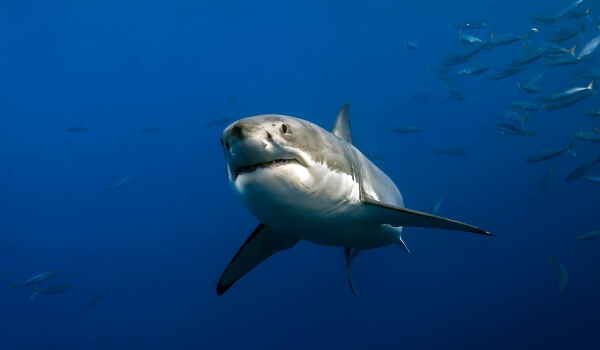
Photo: Great White Shark
It is generally accepted that the great white shark is a solitary predator. In general, this is true, however, when it comes to coastal hunting, sharks can huddle in flocks of two to five individuals. In this temporary grouping, there is one alpha leader, and the remaining members play well-defined roles. Such an organization is very similar to the hunting of a wolf pack.
As for the hierarchy among white sharks, the situation here is in the best traditions of matriarchy. Females dominate males due to the fact that they are significantly larger than them. Conflicts within a social group are resolved at the level of demonstrative punishment in the form of mild, warning bites.
Unlike its counterparts, the great white shark is sometimes able to raise its head out of the water to better see the prey and generally scout the situation. This extraordinary skill of the sea predator is often displayed in documentaries and feature films about wildlife, thanks to which the role of a cold-blooded and prudent killer has firmly entrenched the white shark. White sharks are considered to be underwater centenarians. Most of them live up to 70 years or more, unless, of course, they fall into the net of poachers or are eaten by other, even more bloodthirsty predators.
Social structure and reproduction
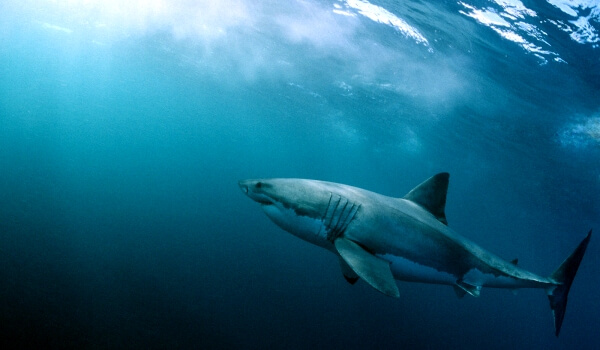
Photo: The Greatest White Shark
Great white sharks prefer to be alone for most of their lives. Their authoritative nature does not tolerate competition and rivalry, they are ready to go only for a short cooperation for the sake of a big jackpot in the form of a sea lion or a flock of dolphins. Females will never give up the role of alpha in a social group to males. An interesting fact is occasional cannibalism among white sharks.
Once, a company of Australian fishermen had a chance to watch a frightening sight, as one six-meter shark in an instant bit another, smaller individual in half.
Great white sharks mature for quite a long time to continue the species. Usually, they have the ability to reproduce only by the age of 30 in females and by 25 years of age in males. These marine predators belong to the category of egg-bearing fish. This means that the eggs fertilized by the male, the shark carries throughout the pregnancy in its womb until the very moment of birth.
The body of a female white shark is designed to carry from two to twelve embryos at the same time. However, already in the womb, these future conquerors of the seas initially behave like born killers. Stronger individuals eat the weak ones, thus, by the time of birth, usually only two or three cubs remain alive.
The gestation period for the great white shark lasts a full eleven months. After birth, young individuals immediately begin to hunt on their own and are absolutely not attached to their mother. Unfortunately, not all cubs are destined to live to see their first birthday. The ocean is cruel and does not tolerate weakness. All of these factors, including long puberty, a long gestation period, and low birth rates, are one of the fundamental reasons for the impending extinction of this rare animal species.
Natural enemies of the great white shark white shark
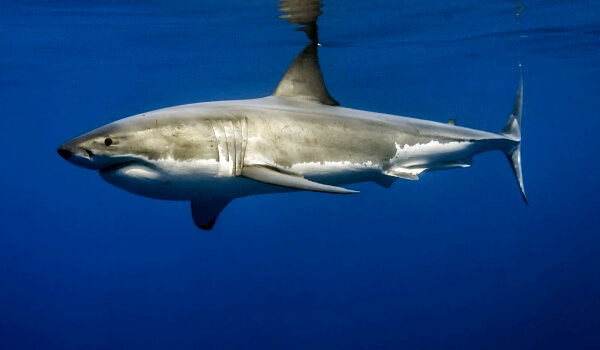
Photo: White Shark
Few people dare to claim the role of the sworn enemy of such a formidable predator as the great white shark. However, nature is very wise and for every action there is always a force of opposition. If we analyze life in the ocean in detail, we can distinguish several natural “enemies” of the white shark:
- other sharks – as already noted, these predators do not disdain cannibalism, or can inflict a mortal wound on their relatives in the process of competition;
- killer whales – this species of whales is the most dangerous for both sharks and and for other inhabitants of the ocean. They are agile, intelligent, sociable and very strong. The outcome of a fight between a killer whale and a white shark will most likely be unpredictable.
- hedgehog fish – this seemingly harmless inhabitant of the deep sea can cause the painful death of a great white shark. Getting into the mouth of a predator, the hedgehog fish swells to an impressive size, injuring the shark’s throat. In addition, her body is covered with poisonous spikes, which gradually leads to intoxication and the painful death of a predator.
- Man – Unfortunately, in today’s civilized society, it is not uncommon for great white sharks to be deliberately killed for their fins, teeth, ribs, or idle curiosity. In addition, the fame of shark — cannibal, which further provokes aggression on the part of a person. Indeed, cases of attacks on people are not so rare, but it is worth noting the fact that divers, surfers and fishermen do not follow basic safety precautions in the habitats of white sharks. The fact is that from the depths a person sailing on a board or boat looks very similar to a sea lion or a seal. The shark simply confuses people with its usual prey.
Species population and status
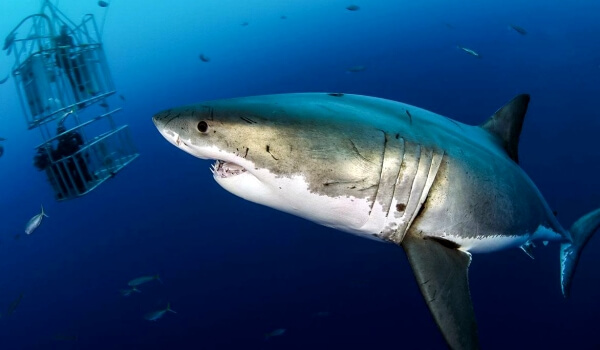
Photo: Great White Shark
Today, the total population of great white sharks is approximately 3,500 individuals. Most of these white-bellied predators settled near Dyer Island (South Africa). It is here that numerous ichthyological studies are carried out, thanks to which we know so much about the lifestyle of this species of sharks.
It is a shame to admit, but at the moment this majestic ancient animal is on the verge of extinction. A third of the total population of great white sharks is exterminated by man through stupidity, greed and ignorance. Shark fins are credited with healing properties, some doctors predict their ability to defeat cancer and other deadly diseases.
Among South African natives, killing a white shark is considered the highest measure of courage. The teeth of a defeated animal often become a totemic decoration. The general aggressive attitude towards these marine life is inspired by numerous stories about the most severe attacks of white sharks on people. However, is it right to accuse wildlife of the fact that we ourselves treacherously invade its territory? The answer is disappointing and is already imprinted on the pages of the International Red Book. White sharks continue to disappear and this process will probably never be stopped.
Great White Shark Conservation
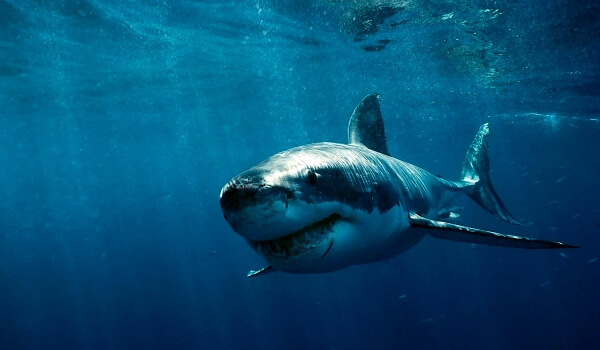
Photo: Great White Shark
This ancient predator is quite justifiably under international protection. The role of the white shark in the ecosystem of the world’s oceans cannot be overestimated. They, like wolves in the forest, play the role of nurses in the deep sea, controlling the number of animals and fish. The disappearance of one link can lead to the destruction of the entire food chain.
The decline in the population of white sharks is reflected in the pages of the International Red Book. They stand on the same level as endangered turtles, sperm whales and manatees. As you know, the decreasing number of white-bellied predators is adversely affected by unreasonable human behavior. The global conservation community is trying to rectify this situation by allocating multi-million dollar grants and drawing up special programs aimed at saving great white sharks.
Ichthyologists – geneticists have been trying to recreate the genotype of these powerful predators for a long time in order to try to grow part of the population in artificially created conditions. In addition, the world market has imposed a general veto on the purchase and sale of shark meat. It remains to be hoped that these measures will help nature maintain its natural balance and great white sharks as an integral part of it.
We cannot allow the conquerors of the deep sea to disappear forever. The great white shark survived millions of years of evolution, natural disasters that killed many ancient animals, but man turned out to be stronger. It is in our power to define this force in a positive direction and embark on the path of creating and preserving what we have.


